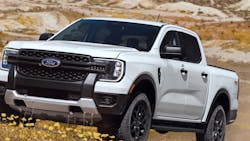Ford’s Farley: Next-Gen EVs Will Need to Turn Profit In First Year
Jim Farley has set the bar: Ford Motor Co.’s second-generation of electric vehicles will need to be profitable within 12 months of being launched later this decade.
The president and CEO of Ford said Feb. 6 the company’s “ultimate competition” in the EV market will be Tesla Inc.’s planned cheaper EV as well as Chinese competitors. To measure up to those products, he said on Ford’s fourth-quarter earnings conference call, his team will push hard to lower manufacturing costs and trim capital spending where it can: Capex this year is forecast to be between $8 billion and $9.5 billion versus $8.2 billion in 2023.
Another key factor in meeting the profitability goal, Farley told analysts and investors, will be “a super-talented skunkworks team” that has been working on a platform for making lower-cost and smaller EVs that will be better able to integrate technologies for which Ford can set up subscriptions.
“We made a bet in silence two years ago,” Farley said on the conference call. “It was a […] small team, some of the best EV engineers in the world, and it was separate from the Ford mothership. It was a startup and they’ve developed a flexible platform that will not only deploy to several types of vehicles but will be a large install base for software and services that we’re now seeing at Pro.”
Ford has used isolated development teams several times throughout the past decade to launch strategic, or just-plain-cool projects. The 2017 GT supercar came out of a similar skunkworks team with many engineers sneaking into a basement design studio after hours.
Plowing a path to EV profitability is a big ask: Ford’s Model e division housing its EV operations posted a 2023 loss before interest and taxes of $4.7 billion and that figure is likely to grow a bit this year because of price cuts Ford and other companies have had to institute as consumers have become choosier. Farley and his lieutenants don’t expect to close that entire gap by the end of 2026, the year they plan to begin launching Ford’s second generation of EVs, and aren’t committing to a timeline for making all of Model e profitable.
Ford’s Q4 Financials At-a-Glance
Ford posted a fourth-quarter net loss of $526 million on revenues of $46.0 billion. A year earlier, it had earned $1.3 billion on sales of $44.0 billion but growing losses from its EVs unit and a one-time pension accounting charge hurt the bottom line.
Adjusted earnings before interest and taxes came in at $1.1 billion versus $2.6 billion in late 2022 and were flat at $10.4 billion for the full year. Executives are forecasting a range of $10 billion to $12 billion for 2024.
Check out the company’s full earnings statement here.
“We have no choice,” CFO John Lawler said about continuing to invest in EVs. “We will continue to work on improving the cost structure of the Gen 1 vehicles. And as Jim said, our Gen 2 vehicles won’t launch unless we can get to a profit and a return on that capital that we’re investing there at the pricing environment that we now understand is reality. […] It is very much the mother of all optimization modeling.”
The Ford team’s goals and obstacles sound a lot like those of Tesla, where CEO Elon Musk recently said his team will this year ramp up capex to more than $10 billion as it targets a late-2025 production start of its next-generation vehicle, which will use new manufacturing tools and techniques. But, Farley on Feb. 6 also echoed some other auto manufacturing executives’ recent comments on the benefits and successes of hybrid vehicles.
Ford’s sales of those rose 20% in 2023 and Farley forecast growth of 40% this year, with the company’s trucks driving those gains. In California, he noted, half of the F-150 trucks solid during the fourth quarter were powered either by hybrid or electric engines.
Shares of Ford (Ticker: F) were up more than 3% to about $12.50 in midday trading Feb. 7. Over the past six months, however, they are still down about 4%, leaving the company’s market capitalization at about $50 billion.
About the Author
Geert De Lombaerde
Senior Editor
A native of Belgium, Geert De Lombaerde has been in business journalism since the mid-1990s and writes about public companies, markets and economic trends for Endeavor Business Media publications, focusing on IndustryWeek, FleetOwner, Oil & Gas Journal, T&D World and Healthcare Innovation. He also curates the twice-monthly Market Moves Strategy newsletter that showcases Endeavor stories on strategy, leadership and investment and contributes to other Market Moves newsletters.
With a degree in journalism from the University of Missouri, he began his reporting career at the Business Courier in Cincinnati in 1997, initially covering retail and the courts before shifting to banking, insurance and investing. He later was managing editor and editor of the Nashville Business Journal before being named editor of the Nashville Post in early 2008. He led a team that helped grow the Post's online traffic more than fivefold before joining Endeavor in September 2021.
